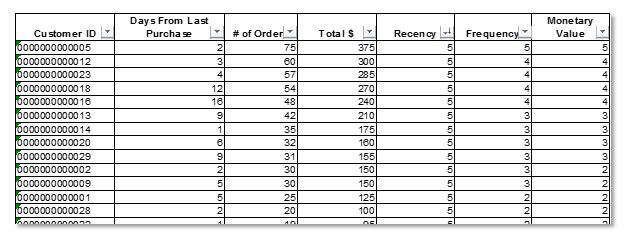SHARE
How to Leverage Behavior-Based Customer Segmentation
Everyone has heard of the 80/20 rule, also known as the Pareto Principle—80% of your revenue comes from 20% of your customers—but RFM is the best way to determine the actual makeup of your customer base and gain insights to help improve your targeting, messaging and marketing ROI.
RFM analysis is the first step in helping you define customer segments within your portfolio of customers.
R – How recent was their last purchase?
F – How frequently do they transact with your brand?
M – What is their monetary value to the brand?
When combining these three parameters, you will have not only a strong understanding of the value of each customer, but an ability to communicate with the customer in a way that is personalized to them. You will be able to identify if a customer is about to churn or who is on the cusp of becoming a loyalist. It’ll even help you optimize your marketing dollars by allocating funds to the segments that will make the biggest impact on revenue.
Now let’s get started. First, you will need some sort of unique identifier (e.g., email address, account ID, customer ID, etc.). Next, assign the following values to each customer:
- Regency – Number of days since the last purchase
- Frequency – Total number of transactions over the past two years (or longer)
- Monetary Value – How much the customer has spent over the past two years (or longer)
Now that you have the RFM values, you will need to assign RFM scores to each customer. To calculate the score, sort the RFM values from highest to lowest, then establish quintiles (five equal parts based on value ranges).

Based on the combination of scores, you can now determine which customers are the most valuable. For example, your most loyal customer will have a Frequency score of 5. Depending on their Monetary Value, they could potentially be one of your best customers or have potential to become one of your best. Conversely, if you have a group of customers with an RFM score of 111, you could optimize your marketing ROI by suppressing this segment from campaigns. Worried about losing your best customers? Create churn mitigation strategies for those that have a Recency score of 2 with a Frequency and Monetary score of 4 or 5.
As you develop your RFM Model and customer segments, the final step is to establish necessary actions and messaging for each customer segment. How will you message the customer? What is the metric that will drive overall spend, and what offers or selling propositions will work best? When is the optimal time to communicate with the customer? Is the total customer spend driven by high frequency or high spend per visit? Finally, as you roll out your RFM tactics, test and evaluate if customers are migrating to the desired segment based on your actions.
While RFM modeling takes some time, effort and data technology to set up, it is extremely useful for a variety of businesses ranging from retail to nonprofits. Consider building your RFM program and leveraging it for actionable consumer profiling/modeling, refining direct response communications, improving customer LTV, proactive churn mitigation, richer loyalty programs, relevant remarketing/retargeting, timely trigger programs, data-informed product development and launches, and, most importantly, revenue optimization.
How to Leverage Behavior-Based Customer Segmentation
SHARE
Everyone has heard of the 80/20 rule, also known as the Pareto Principle—80% of your revenue comes from 20% of your customers—but RFM is the best way to determine the actual makeup of your customer base and gain insights to help improve your targeting, messaging and marketing ROI.
RFM analysis is the first step in helping you define customer segments within your portfolio of customers.
R – How recent was their last purchase?
F – How frequently do they transact with your brand?
M – What is their monetary value to the brand?
When combining these three parameters, you will have not only a strong understanding of the value of each customer, but an ability to communicate with the customer in a way that is personalized to them. You will be able to identify if a customer is about to churn or who is on the cusp of becoming a loyalist. It’ll even help you optimize your marketing dollars by allocating funds to the segments that will make the biggest impact on revenue.
Now let’s get started. First, you will need some sort of unique identifier (e.g., email address, account ID, customer ID, etc.). Next, assign the following values to each customer:
- Regency – Number of days since the last purchase
- Frequency – Total number of transactions over the past two years (or longer)
- Monetary Value – How much the customer has spent over the past two years (or longer)
Now that you have the RFM values, you will need to assign RFM scores to each customer. To calculate the score, sort the RFM values from highest to lowest, then establish quintiles (five equal parts based on value ranges).

Based on the combination of scores, you can now determine which customers are the most valuable. For example, your most loyal customer will have a Frequency score of 5. Depending on their Monetary Value, they could potentially be one of your best customers or have potential to become one of your best. Conversely, if you have a group of customers with an RFM score of 111, you could optimize your marketing ROI by suppressing this segment from campaigns. Worried about losing your best customers? Create churn mitigation strategies for those that have a Recency score of 2 with a Frequency and Monetary score of 4 or 5.
As you develop your RFM Model and customer segments, the final step is to establish necessary actions and messaging for each customer segment. How will you message the customer? What is the metric that will drive overall spend, and what offers or selling propositions will work best? When is the optimal time to communicate with the customer? Is the total customer spend driven by high frequency or high spend per visit? Finally, as you roll out your RFM tactics, test and evaluate if customers are migrating to the desired segment based on your actions.
While RFM modeling takes some time, effort and data technology to set up, it is extremely useful for a variety of businesses ranging from retail to nonprofits. Consider building your RFM program and leveraging it for actionable consumer profiling/modeling, refining direct response communications, improving customer LTV, proactive churn mitigation, richer loyalty programs, relevant remarketing/retargeting, timely trigger programs, data-informed product development and launches, and, most importantly, revenue optimization.
How to Leverage Behavior-Based Customer Segmentation
SHARE
Everyone has heard of the 80/20 rule, also known as the Pareto Principle—80% of your revenue comes from 20% of your customers—but RFM is the best way to determine the actual makeup of your customer base and gain insights to help improve your targeting, messaging and marketing ROI.
RFM analysis is the first step in helping you define customer segments within your portfolio of customers.
R – How recent was their last purchase?
F – How frequently do they transact with your brand?
M – What is their monetary value to the brand?
When combining these three parameters, you will have not only a strong understanding of the value of each customer, but an ability to communicate with the customer in a way that is personalized to them. You will be able to identify if a customer is about to churn or who is on the cusp of becoming a loyalist. It’ll even help you optimize your marketing dollars by allocating funds to the segments that will make the biggest impact on revenue.
Now let’s get started. First, you will need some sort of unique identifier (e.g., email address, account ID, customer ID, etc.). Next, assign the following values to each customer:
- Regency – Number of days since the last purchase
- Frequency – Total number of transactions over the past two years (or longer)
- Monetary Value – How much the customer has spent over the past two years (or longer)
Now that you have the RFM values, you will need to assign RFM scores to each customer. To calculate the score, sort the RFM values from highest to lowest, then establish quintiles (five equal parts based on value ranges).

Based on the combination of scores, you can now determine which customers are the most valuable. For example, your most loyal customer will have a Frequency score of 5. Depending on their Monetary Value, they could potentially be one of your best customers or have potential to become one of your best. Conversely, if you have a group of customers with an RFM score of 111, you could optimize your marketing ROI by suppressing this segment from campaigns. Worried about losing your best customers? Create churn mitigation strategies for those that have a Recency score of 2 with a Frequency and Monetary score of 4 or 5.
As you develop your RFM Model and customer segments, the final step is to establish necessary actions and messaging for each customer segment. How will you message the customer? What is the metric that will drive overall spend, and what offers or selling propositions will work best? When is the optimal time to communicate with the customer? Is the total customer spend driven by high frequency or high spend per visit? Finally, as you roll out your RFM tactics, test and evaluate if customers are migrating to the desired segment based on your actions.
While RFM modeling takes some time, effort and data technology to set up, it is extremely useful for a variety of businesses ranging from retail to nonprofits. Consider building your RFM program and leveraging it for actionable consumer profiling/modeling, refining direct response communications, improving customer LTV, proactive churn mitigation, richer loyalty programs, relevant remarketing/retargeting, timely trigger programs, data-informed product development and launches, and, most importantly, revenue optimization.
